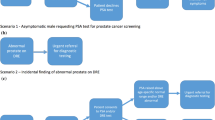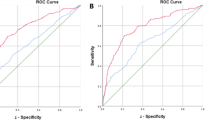Abstract
Background: This study was designed to determine the efficacy of digital rectal examination (DRE) and serum prostate-specific antigen (PSA) for early detection of prostate cancer in men ≥50 years of age.
Methods: A prospective single-center clinical trial was conducted to screen 644 asymptomatic men, who were elicited by newspaper and radio advertisements, with DRE and PSA. Quadrant biopsy examinations of the prostate were performed if PSA >4 ng/ml or if DRE was suspicious.
Results: Thirty-seven percent of the men (n=241) had an abnormality of DRE or elevated PSA. Of the 163 patients who underwent transrectal ultrasound and quadrant biopsies of the prostate, 77% had normal biopsies, 14 (8%) had prostatic intraepithelial neoplasia, and 24 (15%) had carcinoma of the prostate. PSAs ranged from 0.3 to 65.5 ng/ml, with a mean of 2.35 and a median of 1.6. Ninety-five patients had a PSA >4 ng/ml, of whom 17 had a PSA >10 ng/ml. Sensitivity of PSA was 75% and specificity 87%; for DRE the sensitivity was 75% and the specificity 69%. Clinical stage of patients who underwent radical prostatectomy was B1 in 15 and B2 in five. Fifteen of 20 patients (75%) had organ-confined disease; the other five had specimen-confined disease. No patient was found to have nodal involvement.
Conclusion: The combination of PSA and DRE seems to improve the stage of diagnosis of patients with prostate cancer. Larger, randomized studies will be necessary to evaluate the effect of screening on overall survival.
Similar content being viewed by others
References
Boring CC, Squires TS, Tong T. Cancer Statistics, 1993.CA 1993;43:7–26.
Lee F, Gray JM, McCleary RD, et al. Transrectal ultrasound in the diagnosis of prostate cancer: echogenicity, histopatology and staging.Prostate 1985;7:117.
Watson RA, Tang DB. The predictive value of prostatic acid phosphatase as a screening test for prostate cancer.N Engl J Med 1980;303:497.
Oesterling JE. Prostate specific antigen: a critical assessment of the most useful tumor marker for adenocarcinoma of the prostate.J Urol 1991;145:907–23.
Chodak GW, Keller P, Schoenberg HW. Assessment of screening for prostate cancer using the digital rectal examination.J Urol 1989;141:1136.
Thompson IM, Ernst JJ, Gangai N, Spence CR. Adenocarcinoma of the prostate: results of routine urological screening.J Urol 1984;132:690.
Catalona WJ, Smith DS, Ratliff TL, et al. Measurement of prostate specific antigen in serum as a screening test for prostate cancer.N Engl J Med 1991;324:1156.
Cooner WH, Moseley BR, Rutherford CL, et al. Prostate cancer detection in a clinical urological practice by ultrasonography, digital rectal examination and prostate specific antigen.J Urol 1990;143:1146–54.
Stamey TA, Fraeiha FS, McNeal JE, et al. Relationship of tumor volume to clinical significance for treatment of prostate cancer.J Urol 1992;147:303.
Author information
Authors and Affiliations
Rights and permissions
About this article
Cite this article
Richie, J.P., Kavoussi, L.R., Ho, G.T. et al. Prostate cancer screening: Role of digital rectal examination and prostate-specific antigen. Annals of Surgical Oncology 1, 117–120 (1994). https://doi.org/10.1007/BF02303554
Received:
Accepted:
Issue Date:
DOI: https://doi.org/10.1007/BF02303554




